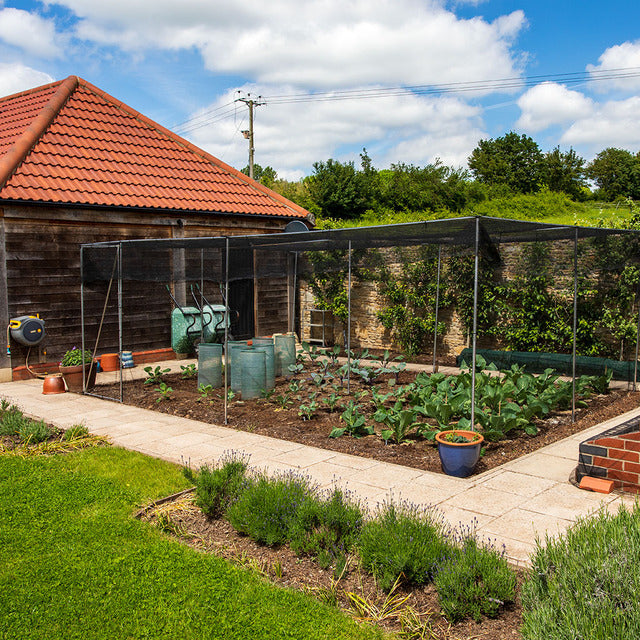A fruit cage is a great investment if you want to maximise your chances of success when growing fruit trees, cane fruits and fruit bushes. It can remove the worry of pests - and help make sure you get to your harvest before the birds do - as well as providing a physical barrier which allows you to garden organically without reducing your yield.
Planning the layout and design of your fruit cage before you introduce the physical structure will help make sure you make the most of your space - So here are some of our best tips to guide you.
What To Grow In Your Fruit Cage
Think carefully about what varieties will thrive in the conditions and what produce you will enjoy growing and eating. Traditionally raspberries, blackberries, currants, gooseberries, blueberries and strawberries are fruit cage favourites, but dwarf fruit trees such as cherry and plum may also benefit from the extra care and protection you can give to them. And don’t forget vegetables which are often damaged by birds such as brassicas and salads.
Make a list of fruit cage project ideas and do some research on how much space they will require as mature plants - remember your fruit cage will be with you for years and it is better not to be tempted to overcrowd it initially - you can always make use of any spare space with salads, herbs and even flowers for cutting which will help attract pollinating insects.

Choosing Your Fruit Cage
When deciding what size or style of cage you opt for you will naturally be limited by the amount of available space in your garden and where you plan to site it. Ideally you should look for an area which is relatively level both to make installation more straightforward and to ensure that your cage remains structurally secure for years to come.
You may plan to use the cage to cover existing beds or start from scratch - raised beds on a paved area or hardstanding can work very well for example and may be easier to tend so don’t rule out repurposing a previously uncultivated space. If you have a larger garden you may have more scope to grow full sized fruit trees or larger soft fruit bushes, but even in a small kitchen garden there are many dwarf or cordon varieties which can produce a very worthwhile crop.
While it is always good to make sure you allow sufficient space for your plants to grow well, do think about how much time you are able to devote to keeping your cage well tended - bigger is not always better!
Plan Your Access
Think about where to place the door to your cage - does it give convenient access for a wheelbarrow? Is it easy to reach your water source? Is there a pathway to avoid damaging your lawn with excess traffic? Make sure you leave sufficient space between beds or planting within the cage to work comfortably around them for tending and harvest - remember many fruit bushes are also prickly and you need to avoid having to work with a spiny gooseberry bush at your heels!
Make sure that you can reach all your plants without treading on the growing areas, which can damage the soil and cause compaction. If your cage is big enough then laying paths inside will help you work effectively and separate out the different growing areas.
Consider the Soil
All the best fruit cage ideas and projects live and die by soil quality and principles. Most soft fruit prefer slightly acidic soil and some, such as blueberries will do much better in ericaceous compost, mulched regularly with materials such as pine needles or other acidic organic matter. Your fruit cage should be well prepared before planting to provide well drained conditions with plenty of organic matter incorporated into the soil to feed the hungry cropping bushes.
Using a weed suppressing membrane can be very helpful in maintaining your beds - bushes can be planted directly through the fabric - but make sure that it is water permeable to prevent the soil from drying out.
Sunlight & Shade
Generally fruit trees, cane fruits and fruit/ berry bushes will crop better in areas which receive plenty of sun, so make sure you position your plants so that those that grow tall do not block light from shorter varieties.
Place trees and large bushes to the north side of the cage to ensure they do not block the light from lower growing plants. But there will be occasions when some shade is beneficial especially in high summer so consider how you can provide this, either with shade casting plants or a shading fabric.
Grow in Containers
Containers can be very useful in a fruit cage as you can move them around according to where you have space or to make the most of the sun to ripen fruit, so it is worth including some space for planters or large pots in your plan so that they do not get in the way or prevent you from getting your barrow where you need it.
Companion Planting
Placing herbs, flowers and other beneficial companion plants can really aid good fruit production and adding a container of bee friendly planting allows you to position it for best pollinating advantage.











Leave a comment